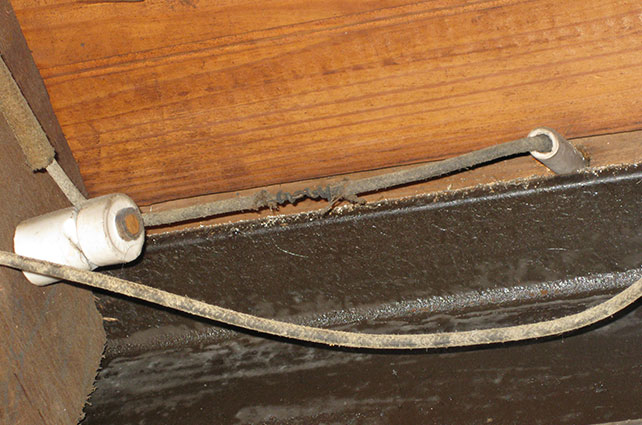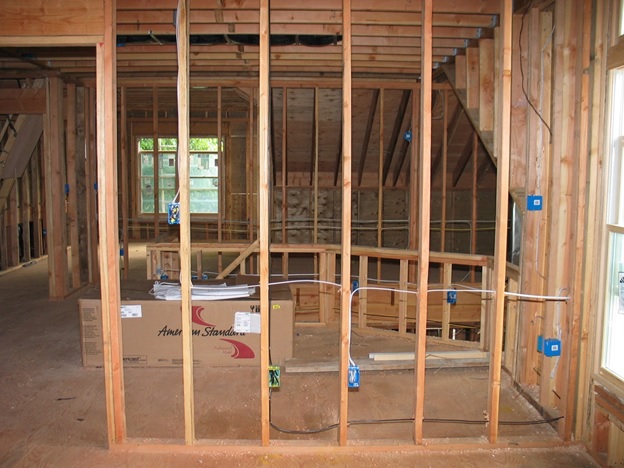What Is Knob And Tube Wiring?
Knob and tube wiring refers to the first generation of electrical wiring. It was installed in homes between 1900 and 1950. While it was once considered cutting-edge technology, knob and tube systems are largely considered risky, and having this type of wiring may make your home non-insurable.
Knob and tube conductors are characterized by single wires wrapped in a cloth-based sheath. The conductors run in parallel pairs and are supported by porcelain tubes and as they travel through wooden framing members, and porcelain knobs as they travel along wooden framing members. The conductors must be physically separated to prevent them from shorting out. It is considered a free-air wiring system.
Is It Safe?
Here are 3 technical issues to be concerned about:
- There is no ground wire. The main reason for ground wires is to help prevent shocks. Knob and tube wiring is not grounded.
- It is a free-air wiring system. Most homes have attics with insulation. Many insulation contractors will not insulate homes with knob and tube wiring due to law suits.
- It predates temperature ratings on wire. Yes, in fact, it is older than radio.
Some inspection agencies claim it is not inherently dangerous provided that:
- The insulation is intact – You really cannot see very much of the wiring in most homes, although it is generally most affected above ceiling-mounted light fixtures because of long-term exposure to heat from light bulbs. Knob and tube wiring predates temperature ratings, so no one really is sure what rating it has. Two generations later, most home wires were rated for 75°C. For almost 40 years, the standard has been 90°C. Many light fixtures require this temperature rating to be safely installed.
- Additional outlets have not been added to it – Every house old enough to have knob and tube wiring has had some electrical additions. Some are no doubt done professionally by a licensed electrician, and many are not. Too many outlets on a circuit is a problem for any type of wiring.
- The wires are properly protected by the correct fuse or breaker – All wiring should be properly protected by the correct size of breaker.
Will It Affect My Ability To Get Insurance Coverage?
Some insurance companies refuse to provide coverage for homes with knob and tube wiring because of their unreliability and safety concerns. The following reasons are often cited as reasons to decline coverage:
- Knob and tube systems weren’t designed to meet modern electrical requirements. Considering that simply making toast and coffee in the morning demands about 20 amps of electricity, it’s easy to see how your electrical system will be quickly overloaded. Many light fixtures also require 90°C wires, which are frequently overlooked.
- Knob and tube systems aren’t grounded, which is now a code requirement for electrical installations. Grounded circuits are safer because they reduce the risk of shock if an appliance malfunctions.
- Knob and tube systems aren’t easily accessible because they’re installed behind the walls. This makes them more difficult to inspect for safety concerns.
Common Signs You Might Have Knob and Tube Electrical in Your Home
You don’t have to tear down walls to start identifying the signs. Some common clues include:
- Two-prong outlets throughout the house
- Wires covered in cloth rather than modern plastic insulation
- Porcelain knobs or tubes visible in your basement or attic
- Flickering lights, tripped breakers, or burning smells from outlets
Homeowners who notice these signs should act quickly. A thorough inspection by a licensed electrician familiar with knob and tube electrical systems can help you determine the current condition and scope of any necessary knob and tube rewiring.
Benefits of Upgrading from Electrical Knob and Tube Wiring
While the safety improvements alone make a compelling case, there are several other benefits to replacing outdated systems:
- Energy Efficiency: Newer systems allow for better power distribution, minimizing wasted electricity.
- Increased Home Value: Many buyers are wary of homes with knob and tube wiring. Completing the upgrade can increase buyer confidence.
- Peace of Mind: Knowing your wiring meets current safety standards eliminates the worry of unseen hazards lurking in the walls.
These advantages demonstrate that knob and tube rewiring isn’t just about complying with insurance—it’s about bringing your home up to modern standards for comfort and safety.
Real Estate Impacts: Selling a Home with Knob and Tube Wiring
If you’re planning to sell a property that still has knob and tube wiring, expect buyers to bring up concerns during the home inspection process. Many real estate transactions fall through or are delayed due to outdated knob and tube electrical systems. Additionally, mortgage lenders and insurers may require documented proof of knob and tube rewiring before approving a loan or coverage.
Sellers can avoid negotiation setbacks by proactively replacing electrical knob and tube wiring before listing the home. Buyers will appreciate the upgrade, and it provides an edge in competitive markets.
Why Expertise Matters in Rewiring Knob and Tube Systems
Not every electrician is trained or equipped to handle knob and tube rewiring projects. These systems are older, nuanced, and require knowledge beyond typical modern wiring installations. Choosing a contractor like Langstaff and Sloan—who have specialized in knob and tube electrical work for decades—ensures not only safety but accuracy and adherence to code.
Skilled professionals can also coordinate with your home inspector or insurance provider, helping you navigate approvals and paperwork more easily.
Plan Ahead: When’s the Best Time to Replace Knob and Tube Wiring?
If you’re undertaking renovations, it’s a prime opportunity to upgrade your knob and tube wiring. Opening walls or ceilings for other projects reduces the added labor needed for knob and tube rewiring, saving both time and money. Seasonal considerations also matter—spring and summer months are often best, as electrical work may require temporary power outages.
Don’t wait for a crisis to act. If your home still runs on electrical knob and tube wiring, now is the right time to consult an expert and map out your next steps.
What Should I Do If My Home Has Knob And Tube Wiring?
Hire a Licensed Electrical Contractor with extensive experience replacing knob and tube type wiring.
Langstaff And Sloan: Specialists In Knob And Tube Replacement Services
Langstaff and Sloan have provided residential and commercial electrical services in the GTA since 1991. Our licenced electricians specialize in knob and tube rewiring, and we also patch and holes that might be required. Langstaff and Sloan are dedicated to providing our clients with reliable services at competitive rates. Contact us today to schedule an assessment and book an appointment.




















